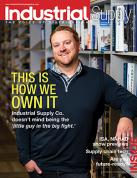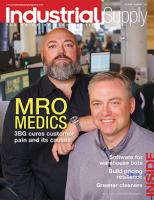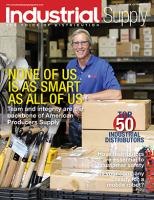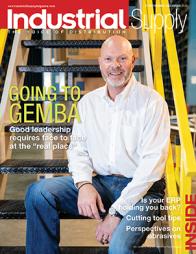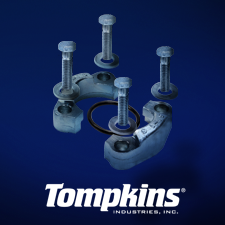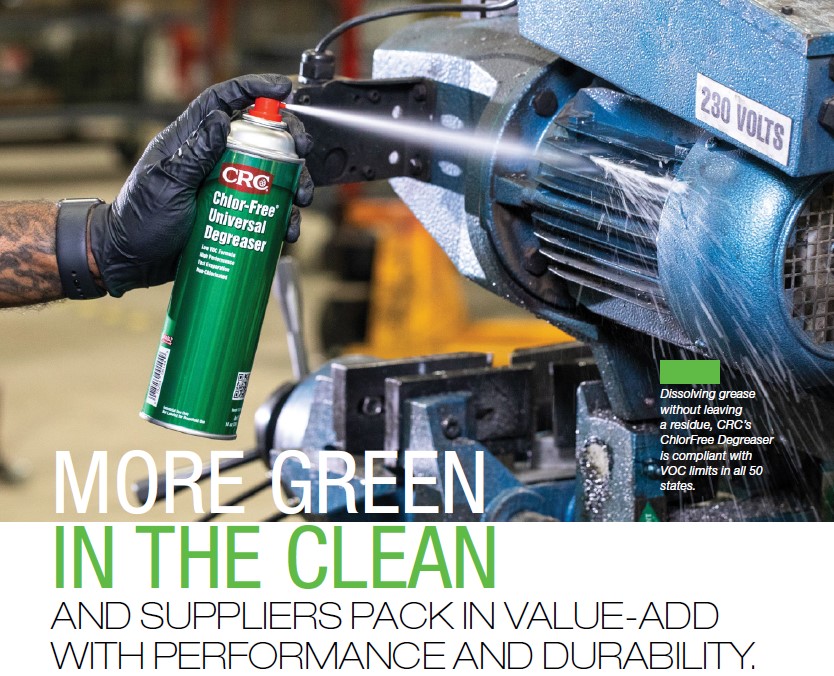 |
Staff Report
Bio-based and enzymatic cleaners are also gaining traction, particularly in sectors like healthcare and food processing, due to their effectiveness and lower environmental impact. There is also a rising demand for ingredient transparency and third-party certifications, which assure buyers of a product’s safety and environmental responsibility.
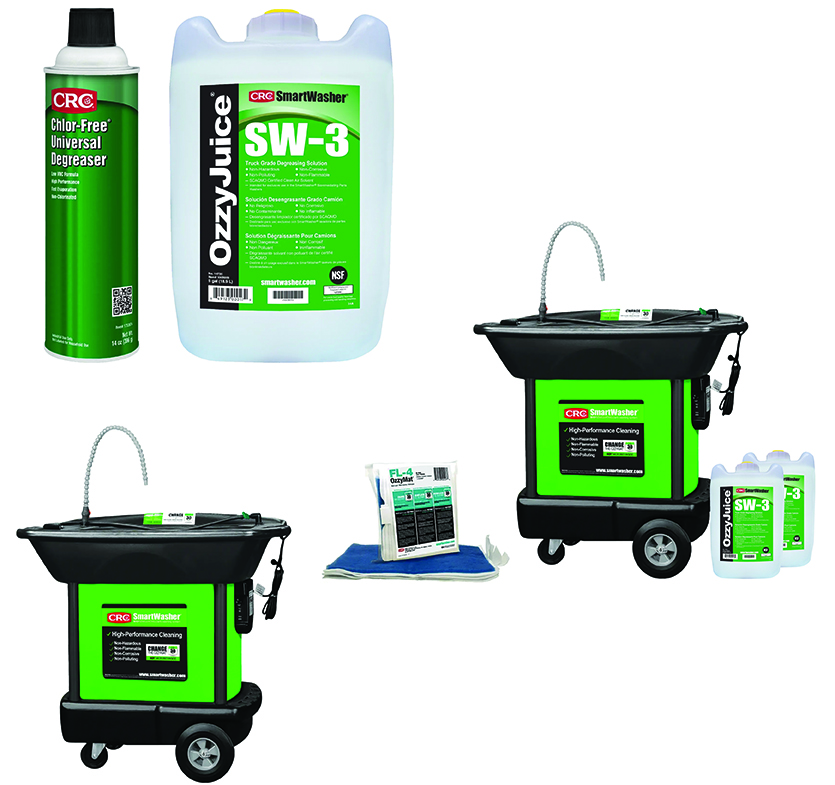 |
| CRC’s Smart Washer is designed for durability. |
In response, CRC Industries developed and launched the Chlor-Free Universal Degreaser. This innovative product was engineered to meet the growing need for industrial degreasers that are both high-performance and compliant with volatile organic compound (VOC) limits across all 50 U.S. states. Recognizing that many existing compliant products underperformed in heavy-duty applications, CRC formulated a non-chlorinated aerosol degreaser that aggressively dissolves grease, dirt, and oils without leaving residue. It features a PowerJet Spray Nozzle for rapid contaminant removal and fast evaporation, minimizing equipment downtime. Rated NSF K1 and safe for use on metals, the degreaser reflects CRC’s commitment to sustainability, worker safety, and regulatory compliance, while maintaining the cleaning power demanded by industrial users.
“As one of the world’s leading manufacturers of MRO chemicals, and a premier partner in regulatory compliance, our experts help distributors and customers navigate safety and regulatory requirements,” said Christie. “The CRC Smart-Washer is the perfect example of a technology developed to improve workplace safety, productivity, value, and durability by offering a powerful, eco-friendly alternative to traditional solvent-based parts washers.”
She adds that SmartWasher’s water-based, non-hazardous cleaning solution eliminates harmful fumes and reduces fire risks. Also, the product’s self-cleaning bioremediation system minimizes maintenance downtime, boosting productivity by keeping operations running smoothly. It has long-lasting filters and fluid to reduce the need for frequent replacements, which adds value over time to the distributor’s customer. “Built with rugged, industrial-grade materials,” Christie said, “the SmartWasher is designed for durability, ensuring reliable performance even in demanding environments.”
LESS WATER MEANS LESS COST
At Hospeco Brands Group, Matt Ahrens, vice president of business development says companies that use their products typically focus on two key priorities: maintaining effective cleaning protocols while minimizing employee exposure to harsh chemicals and, second but not less important, adopting more environmentally responsible practices – even in industrial settings.
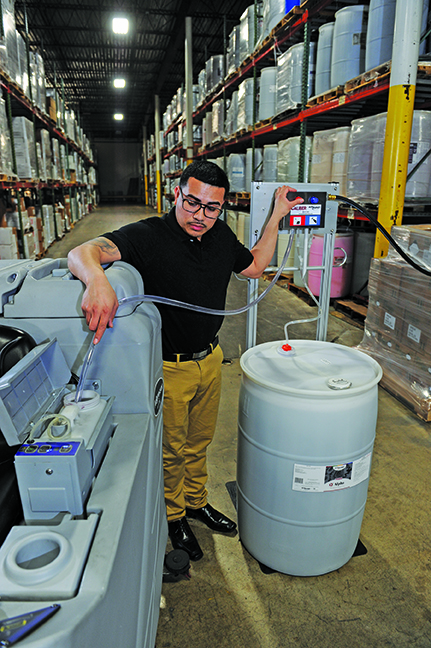 |
| Hospeco Brands Group Cleaning Station is an innovation that enables users to mix and dispense cleaning concentrates. |
“Much of this shift is driven by evolving state regulations,” he said. “To stay compliant, companies increasingly seek third-party certified products, such as those bearing the EPA Safer Choice label, meeting CARB (California Air Resources Board) requirements, or featuring Proposition 65 disclosures. These certifications provide clear proof of compliance and environmental responsibility.
“The move toward greener solutions has also accelerated demand for super-concentrated formulas. By reducing water content, these products lower packaging needs, decrease freight costs, use less fuel, and produce fewer emissions – benefiting the entire supply chain. They also reduce handling and disposal costs, making them a practical and sustainable choice. This trend mirrors what’s happening in the consumer market, with products like ultra-concentrated detergents and single-dose pods gaining popularity.”
Ahrens adds that another emerging trend is the development of cleaners with “direct release” chemistry – formulas deemed safe by the EPA to be discharged directly into drains or sewers without additional treatment. “Ultimately, these trends contribute to safer workplaces, lower liability risks, and easier compliance with increasingly stringent environmental and safety regulations.”
To respond well to market trends, Hospeco Brands Group has developed a survey process to better understand customer needs and pain points. “The insights we gather directly inform our R&D priorities and product development strategy,” said Ahrens.
“One key finding is that while many competitors offer “concentrated” formulas, they’re often still composed of 85% to 95% water. That added water increases costs across the board – adding $65 to $75 in handling and disposal expenses over the life of a single drum,” he continued. “Our focus is on minimizing water content to deliver true super-concentrates. We’ve advanced significantly in this area and made it our No. 1 priority. Paired with our third-party green certifications, this gives us a powerful one-two punch: environmental responsibility and operational efficiency.”
He says the company has also prioritized ease of use. “Our dispensing systems are designed to automatically mix the correct ratio of cleaner to water on site. With the push of a button or pull of a lever, users get consistent, properly diluted product without having to measure manually – or come into direct contact with the chemicals. This not only simplifies usage but also enhances safety and reduces the risk of exposure.”
To drive various improvements, Hospeco Brands Group embraces a multi-faceted approach, from greener chemistry to smarter equipment, Ahrens says.
DISPENSING SAFETY
One major innovation has been the shift toward EPA Safer Choice ingredients and other eco-friendly raw materials, according to Ahrens. Twenty years ago, choosing “green” chemicals often meant sacrificing performance and paying a premium. Today, that’s no longer the case. Modern sustainable cleaners rival traditional formulas in efficacy and cost-effectiveness, proving that we don’t have to choose between safety and performance.
This results in high-efficacy, low-toxicity ingredients. These newer formulations clean just as well as (or better than) the old harsher chemicals, while greatly reducing risks to employees. By cutting out irritants and dangerous solvents, we minimize workers’ exposure to potentially hazardous substances, thereby lowering the chances of chemical-related injuries or lost-time accidents. The improved performance of these products also yields indirect safety benefits – for example, they leave behind less residue, so floors dry clean without a slick film. This means fewer slip-and-fall incidents in recently cleaned areas. In short, safer materials are delivering superior cleaning results without sacrificing performance or worker well-being.
Another area of innovation is in the design of industrial-grade dispensing systems that mix and dispense cleaning concentrates. The team at Hospeco Brands Group has engineered robust dispensing stations with steel construction for maximum durability. Steel components hold up under heavy use, ensuring reliable operation day in and day out. Additionally, the system is built as a freestanding platform, so it can be placed wherever it’s needed on a factory or facility floor – no need to anchor it to a wall or drill into infrastructure. This is a big advantage for customers, who can avoid permanent wall installations and position the unit for optimal workflow. The result is equipment that is both tough and adaptable, reducing maintenance downtime and fitting into a variety of work environments with ease.
“Equally important, our dispensing technology greatly enhances safety and accuracy through closed-loop design, meaning that at every stage – from hooking up a new concentrate container to diluting and dispensing – the chemicals remain sealed within the system,” said Ahrens. “For context, the U.S. EPA estimates that American institutions spend over $75 million a year on medical care and lost wages for janitorial injuries related to chemical exposure, with roughly six out of 100 janitorial workers injured annually by harsh cleaning chemicals. That’s why eliminating direct contact is so critical. Our dispensing units use closed-loop inserts in the concentrate containers, so staff never have to pour or measure chemicals by hand.”
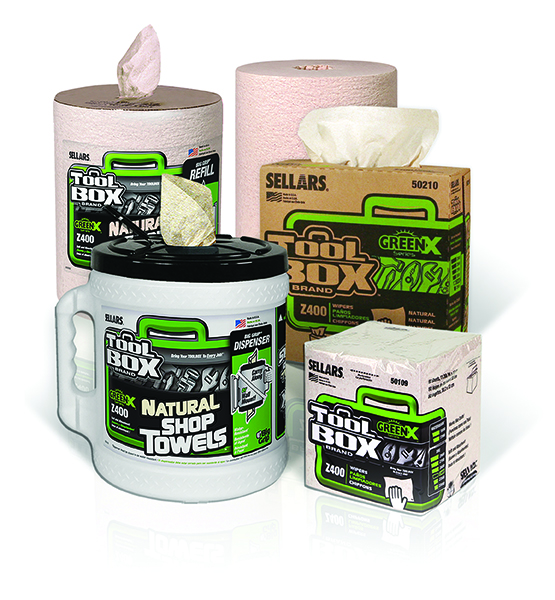 |
| Sellars products. |
REDUCED PACKAGING
Finally, the move toward super-concentrated cleaning products is another game-changer for safety, efficiency, and sustainability, according to Ahrens. These ultra-concentrated formulas pack a lot of cleaning power into a small volume. “For example, some of our new super-concentrates are up to seven times more concentrated than ordinary products – meaning a small container of concentrate can yield as much usable cleaner as several large drums of pre-diluted product. This has enormous practical benefits. Packaging is significantly reduced: instead of handling 50+ gallon drums, staff can handle lightweight 1- to 2.5-gallon concentrate containers.”
Fewer bulky shipments and less packaging material translate to lower supply chain costs and less waste, Ahrens asserts. It’s a more streamlined, cost-effective approach that also helps the environment. With less water and excess packaging being shipped around, the overall carbon footprint shrinks – there’s simply not as much plastic and fuel being used for transporting cleaning solutions. And when those smaller concentrate containers are empty, there’s far less plastic to dispose of or recycle compared to large drums.
At WALTER, Senior Chemical Development Specialist Dr. Saadia Nousir, observes the cleaning industry is undergoing a period of accelerated innovation and transformation. She says this rapid evolution is fueled by a convergence of shifting consumer preferences, tightening environmental and safety regulations, and ongoing technological advancements.
“Consumers are increasingly demanding products that are not only highly effective but also environmentally responsible, non-toxic, and safe for both people and the planet,” said Nousir. “In parallel, regulatory agencies are introducing more rigorous standards focused on lowering chemical exposure, emissions, and environmental impact. Understanding and responding to these dynamics is essential for businesses looking to thrive in this rapidly changing landscape.”
The combined focus on sustainability and regulatory compliance has become a fundamental driver of innovation in the cleaning industry, she notes. Companies are now expected to produce products that adhere to strict environmental and safety standards while reflecting consumer values related to health, ethics, and environmental responsibility. Consequently, businesses are investing in advanced cleaner technologies, eco-friendly chemistry, and sustainable supply chains to satisfy both regulatory demands and evolving market expectations. This shift is not just a response to external pressure; it is also a competitive differentiator. Brands that demonstrate a genuine commitment to sustainability and compliance are earning consumer trust, building brand loyalty, and gaining a strategic edge in a crowded marketplace.
Nousir says WALTER has taken a forward-thinking approach to the evolving needs of the industrial cleaning market by prioritizing sustainability, user safety, and product innovation.
“In response to growing environmental regulations and customer demand for safer alternatives, we’ve engineered a comprehensive lineup of eco-friendly, high-performance cleaning solutions,” Nousir said. “These products are designed to minimize environmental impact without compromising effectiveness and are available in a variety of sizes and delivery systems, including aerosols, bulk containers, wipes, and refillable sprayers to match any application or workflow.
“Whether customers looking for precision parts cleaners designed for specific substrates, ready-to-use cleaning wipes for on-the-go maintenance, non-conductive electrical contact cleaners for sensitive electronics, heavy-duty parts washing systems, or high-strength paint and rust removers, WALTER provides reliable, sustainable options.”
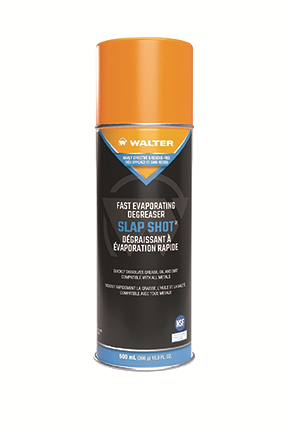 |
| WALTER SlapShot. |
PROACTIVE STRATEGIES
WALTER has designed a wide range of environmentally friendly surface cleaners and degreasers, including water-based and low-VOC solvent solutions to replace traditional toxic solvents. They are non-flammable, VOC-free or VOC-reduced in response to evolving regulations in parts of the US, biodegradable, NSF (Nonfood compounds program) and more efficient than traditional solvents.
Additionally, to align with increasingly strict environmental and safety regulations, WALTER adopted a range of proactive strategies. These include reformulating products to eliminate banned or restricted substances such as phosphates, chlorinated solvents, and PFAS, developing low-VOC or VOC-free solutions, as well as offering biodegradable, non-toxic, and pH-neutral alternatives.
Nousir adds that proper product labelling and featuring hazard symbols, usage guidelines, and disposal instructions are another key compliance measure. “To reinforce our commitment, WALTER seeks third-party certifications, providing credible validation and environmental safety claims,” she said. “WALTER challenges the common belief that sustainable and productive formulations are incompatible. By recognizing the need to maintain formula performance in the development of eco-friendly alternatives, WALTER showcases that environmental responsibility, and productivity can go hand in hand.”
STRONG DEMAND FOR POWERFUL WIPES
Roy Scharrer, director at Working Wipes, says today’s industrial cleaning market is evolving rapidly, with a strong focus on real-world performance and convenience. The No. 1 trend? Demand for powerful, multi-use wipes that work as hard as the people using them.
“Best Working Wipes are engineered to clean hands, tools, and surfaces with ease—no water required, said Scharrer. “They're tough on grease and grime, gentle on hands, and built for any job site. When cleanliness and speed matter, professionals reach for Best Working Wipes.”
He adds that industrial workers don’t have time for “second-rate solutions.”
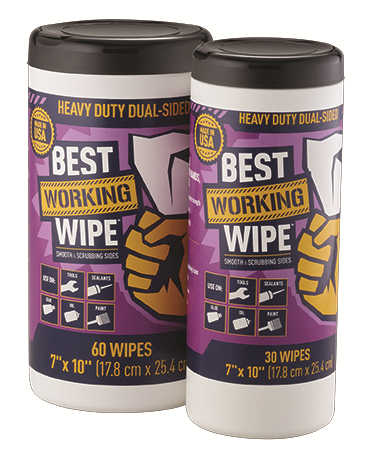 |
| Best Working Wipes. |
“That’s why we designed Best Working Wipes to meet the toughest demands in the field,” Scharrer. “Customers want cleaning products that are fast, effective, and versatile – and that’s exactly what we deliver. Whether it’s grease, oil, tar, paint, adhesives, or caulk, our wipes cut through it all, saving time and hassle. We listen closely to the needs of our customers and respond with high-performance products that get the job done—every time.”
He notes that his company has raised the bar with a more sustainable, high-performance wipe substrate, a major advancement compared to scratchy, low-absorbency polypropylene materials of the past. “Our upgraded design offers greater durability, better absorption, and a superior cleaning experience,” Scharrer said. “The result? A wipe that’s tougher, safer, and more efficient, providing more value with every use. With Best Working Wipes, professionals don’t have to choose between performance and sustainability – they get both.”
MINIMIZING ENVIRONMENTAL IMPACT
Like other sources, Rob Heglin, product marketing manager for Sellars Absorbent Materials, says a growing number of industrial distributors and end users are demanding solutions that minimize environmental impact. Regulatory changes, customer sustainability goals, and ESG initiatives are all driving demand for cleaning products that are biodegradable, reusable, or made from recycled materials,” he says.
“OSHA and EPA regulations are pushing facilities to adopt products that are not only effective but also safer for workers—both from a chemical exposure and fall/slip prevention standpoint. Products that reduce cross-contamination and support safety protocols are gaining traction,” Heglin said.
Another trend in the industrial cleaners’ market is efficiency and cost control. Heglin notes that with labor shortages and rising costs, facilities are seeking products that perform faster, last longer, and help reduce overall spending. Multi-use cleaning products and sorbents that perform in diverse environments offer strong value propositions.
Additionally, says Heglin, customers are demanding versatility and performance in tough environments. “Manufacturers are prioritizing cleaners and wipers that can be used across multiple surfaces and conditions—whether it’s oily shop floors, machinery maintenance, or sanitization in food-grade facilities.”
RECYCLED MATERIALS, ECO-FRIENDLY MANUFACTURING
Sellars is responding to trends in three ways.
1) Commitment to recycled materials and eco-friendly manufacturing. “Our wipers and sorbents are made with anywhere from 25% to up to 90% recycled content, helping customers meet their sustainability goals without sacrificing performance,” he said.
2) Product line diversification for specific applications. “We’ve expanded our product lines to cater to niche markets,” Heglin continued, “from degreasing and heavy-duty industrial wiping to specialty absorbents for chemical spill response.” He adds that customization for sector-specific needs (e.g., automotive, manufacturing, food service) has become a central strategy.
3) Durability and disposable efficiency. Customers want the toughness of a cloth with the disposability of a paper towel, according to Heglin. “Our TOOLBOX wipers and shop towel products, for example, are engineered to outperform traditional rags, offering absorbency and strength with reduced cost-per-use,” he said.
SAFETY-FOCUSED SOLUTIONS
Sellars has launched color-coded systems and low-lint products that help reduce cross-contamination and support compliance in controlled environments. Products like their lint-free wipers are designed to perform in cleanrooms, aerospace, and other sensitive operations.
“We've introduced color-coded wipers that help facilities easily implement hygiene protocols and reduce the risk of cross-contamination, which is especially critical in food processing and healthcare-adjacent industries,” said Heglin.
The company’s TOOLBOX DuraSoak and EverSoak lines are designed for high absorbency and rapid deployment. New design enhancements ensure they hold more fluid per square inch and are easier to handle, store, and dispose of safely.
Sellars says it is constantly exploring combinations of post-consumer recycled fibers in its wipers to maximize tensile strength, reusability, and absorbency. These innovations give customers longer-lasting products without increased material waste.
To enhance workflow in fast-paced environments, Sellars has improved compatibility with wall- and floor-mounted dispensing systems to minimize waste, support one-handed operation, and reduce fatigue.
And responding to growing customer demand for more sustainable supply chain options, the company is transitioning many product lines into reduced-plastic or recyclable packaging solutions, which contributes to a reduction in their own environmental footprint, as well.
SELLARS' PRODUCTS
The GreenX Z400 product is made in the U.S. from up to 60% recycled fibers and was created for medium duty wiping applications such as cleaning machinery, rough surfaces and larger messes. Sellars uses its proprietary DRC manufacturing process to create a cost-effective, sustainable wiper that works like cloth, has incredible scrub strength, and won’t fall apart when wet. The highly absorbent wipers are food safe and free of elemental chlorine and natural latex. The GreenX Z400 wipers are part of the EPA CPG program and are available in one-quarter-fold wipers, interfold wipers, center-pull wipers, jumbo roll wipers and the Big Grip dispenser with refill wipers.
TOOLBOX WaterWeave T800 Wipers are heavy-duty wipers that can stand up to industrial use. Made with technology that “weaves” polypropylene and cellulose fibers together for added strength, the T800 low lint wipers can tackle solvents, jagged edges, rusty surfaces, and caked on grime. Choose one sheet for small spills or, for bigger messes, grab two from the Double-Take Pop-Up Box.
Sellars’ TOOLBOX Blue Shop Towels are made in the U.S. with up to 60% recycled fibers. These highly absorbent, medium-duty towels can tackle grease, oil, and spills. Packaged in a convenient box with built-in handles, these towels provide easy, grab-and-go access.
DEGREASER CLEANS OIL, GREASE, TIRE MARKS
Madison Chemical introduced MARVELLA, a concentrated alkaline degreaser with excellent solvency and water softening characteristics that the company says make it ideal for difficult and unusual cleaning applications.
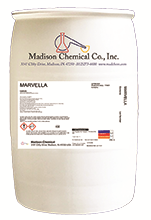 |
| Madison MARVELLA. |
MARVELLA is versatile cleaner that can be applied by hand, mob, scrubbing machine, or low-pressure spray depending upon the application.
MARVELLA is acceptable in food and beverage plants as an A1 general cleaning agent on all surfaces or for use with steam or mechanical cleaning devices in all departments. It is safe for use on stainless and ferrous alloys when used as directed but may etch and attack aluminum and zinc alloys.
Applications for the cleaner include removal of oil, grease, and tire marks from floors, pitch from pulp and paper equipment, in-place engine cleaning, cleaning stove hoods, white side-wall tires, and more.
Distributors are advised to inform customers that before using MARVELLA, food products and packaging materials must be removed from the room or carefully protected. After use, all surfaces must be thoroughly rinsed with potable water.
AUTOMATION, RESHORING IMPACT CLEANER INDUSTRY
Today’s industrial cleaners’ market is being shaped by several trends that are driving product development in notable ways. One major influence is the rise of automation, according to SC Johnson Professional (SCJP). As more facilities incorporate robotic and autonomous equipment into their operations, cleaning products must adapt accordingly.
At the same time, the reshoring of manufacturing to the U.S. is creating new demands. As domestic production begins to grow and productivity continues to be a focus, manufacturers must develop solutions that are both effective and efficient to meet these standards.
In addition to solutions that increase time savings, manufacturers are also looking for other efficiencies, including water and energy savings across their operations. Industrial cleaning products are beginning to reflect this mindset with formulations that minimize water and energy usage while still maintaining high performance.
Lastly, there is renewed attention on safety in recent years. The goal is to make safety not just a policy, but a built-in feature of every product used in the industrial cleaning process.
MEETING A WIDE RANGE OF DEMANDS
SCJP says it supports customers through its broad industrial product portfolio that allows us to meet a wide range of demands. By identifying and categorizing cleaning products based on specific customer needs, we make it easier to match the right product to the right application.
Additionally, to help ensure effective implementation of its products and programs, the company offers both online and in-person training on product use and best practices.
The company says its products, combined with its programs and processes, are designed to enable customers to help reach their sustainability goals.
“Our focus remains on ensuring our current portfolio continues to offer our customers the effective products and solutions they’ve come to expect to help create safe and healthy environments in a sustainable way,” the company told Industrial Supply.
“This includes solutions that meet end users’ varying sustainability targets, while ensuring product efficacy within an industrial environment. For instance, the industrial skin care market is typically 80% solvent-based and 20% solvent-free hand cleaners, but SCJP’s product portfolio offers a more balanced split of 57% solvent-based to 43% solvent-free hand cleaning to better meet shifting needs as market trends and requirements evolve. Additionally, we produce the only foaming heavy-duty grit hand cleaner for industrial environments, which not only saves water and time but provides more hand washes per liter versus competing heavy-duty cleaners while remaining gentle on hands.
This article originally appeared in the July/August 2025 issue of Industrial Supply magazine. Copyright 2025, Direct Business Media.






